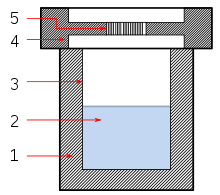Solvothermal synthesis

Solvothermal synthesis is a method of producing
non-aqueous.[1]
Solvothermal synthesis has been used prepare MOFs,[2][3] titanium dioxide,[4] and graphene,[5] carbon spheres,[6] chalcogenides[7] and other materials.
Solvents
Besides water (hydrothermal synthesis), solvothermal syntheses make use of a large range of solvents, including
Formic acid as reaction medium
Formic acid decomposes at high temperatures to carbon dioxide and hydrogen or carbon monoxide and water. This property allows formic acid to be used as a reducing and carbon dioxide-rich reaction medium in which it is possible to form various oxides and carbonates.[8]
Ammonia as reaction medium
The critical temperature and pressure of ammonia are 132.2 °C and 111 bar. In these conditions, it is possible to obtain a range of
dielectric constant is lower than that of water, ammonia behaves as a polar solvent especially at high pressures.[8]
